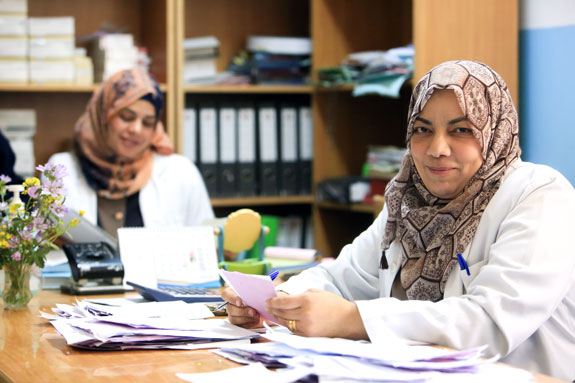
14 Jun Generating Evidence for Staffing Decisions at the Jordan Ministry of Health
The Jordan Ministry of Health spends more than 45 percent of its general budget on salaries and benefits for more than 30,000 people. Still, a lack of data to identify staffing needs and make appropriate staffing decisions often creates inefficiencies.
To overcome the data gap, the USAID HRH2030 (Human Resources for Health in 2030) program is working with the Ministry of Health to roll out the Workload Indicators of Staffing Need (WISN) tool. Developed by the World Health Organization, the WISN tool is an evidence-based method for collecting data and identifying staffing needs based on the actual workload of health workers and services delivered at facilities. The data can be analyzed to strengthen human resources management decisions — staffing levels, health worker distribution, and task sharing — to meet patient needs.
“One of the reasons that I haven’t had strong negotiation power to defend the ministry’s staffing requests is that workload was not measurable. The WISN tool will assist us in generating the needed evidence to back our decisions.”
— Ghaleb Qawasmi, Director of Human Resources Planning and Personnel Affairs, Jordan Ministry of Health
Imbalanced workload and staffing levels also impact health workers’ job satisfaction and service delivery. According to a 2016 HRH2030 study on motivation and retention of health workers at Ministry of Health facilities, nearly 40 percent of more than 1,000 health workers surveyed reported heavy workload as a dissatisfying factor.
“With this number of patients … I just cannot follow up with 100 percent of them,” reported one of the doctors surveyed.
In response to the study findings, HRH2030 recommended critically assessing the actual workload of health workers, facility staffing, and efficiency in relation to current requirements at Ministry of Health facilities. In October 2017, HRH2030 and the Ministry of Health developed an implementation plan and officially launched the WISN tool to 41 key players including representatives from the ministry and relevant health associations.
To optimize WISN’s usefulness, the Ministry of Health, with HRH2030 support, developed web-based software in Arabic to incorporate WISN formulas, aggregate data across sites, generate automated reports, and link to other data sources like the human resources management system.
“[The Ministry] needed a flexible tool that would help us estimate the staffing needs based on workload of health workers. The World Health Organization had a simple Excel [based] WISN software that can do very basic calculations. We have almost 700 health centers and more than 30 hospitals, so we needed a more dynamic system to meet the needs of the ministry,” explained Qawasmi.
The Ministry of Health selected the Balqa Health Directorate for pilot implementation. HRH2030 helped train 25 staff members to collect and enter data into WISN templates, validate and analyze data to identify staffing surpluses or shortages, and propose solutions for major findings. The Balqa staff presented the initial WISN findings to ministry leadership, and the Minister of Health expressed his support of WISN implementation and evidence-based staffing decisions at the ministry.
“After receiving a thorough training on WISN data collection and analysis supported by HRH2030, I managed to collect and analyze data from Ain Al Basha Comprehensive Health Center in Balqa. The initial data shows a heavy workload on some health cadres compared to the number of patients, which indicates that there’s a shortage of staff at that center,” said Dr. Muna Weshah, head of health insurance at the Balqa Health Directorate.
“There are many solutions that WISN can offer to address the workload issue, including task-sharing or health cadre redistribution,” she added.
Based on the WISN data, Al Baqee’ Comprehensive Health Care Center in Balqa also noticed a workforce shortage and conducted internal task-shifting to redistribute the center’s staff.
“We used the data to [justify need for] a family medicine doctor to cover the shortage and fulfill the needs of our patients in Balqa. With around seven thousand patients a month, we got an approval to assign two family medicine doctors to cover six days a week,” noted Ministry of Health Director Fadwa Thabet at the Al Baqee’ Comprehensive Health Care Center.
With the pilot phase complete, HRH2030 and the ministry are rolling out the WISN tool to all health centers throughout the country’s 14 health directorates. In April 2018, the WISN tool was already in use in eight of 14 directorates, with overall progress reaching more than 40 percent. The full rollout is expected to be complete by September 2018.
Photo: Pharmacists at the Ain Al Basha Health Center in Jordan’s Balqa Governorate collect and archive prescriptions. The recent rollout of the WISN tool at their facility revealed a heavy workload on some health cadres compared to the number of patients, which indicates that there’s a shortage of staff at that center, according to Dr. Muna Weshah, head of health insurance at the Balqa Health Directorate. Credit: Mohammad Maghaida, March 2018.





